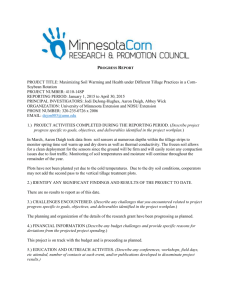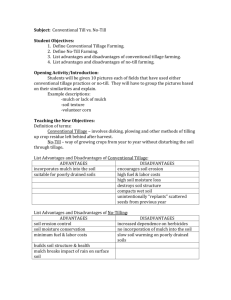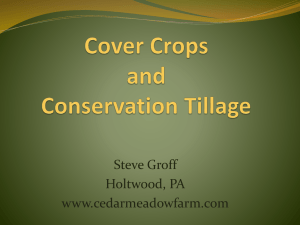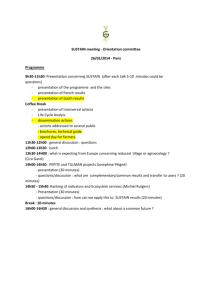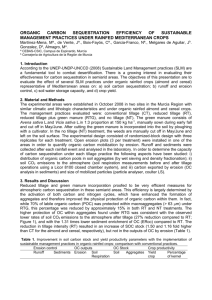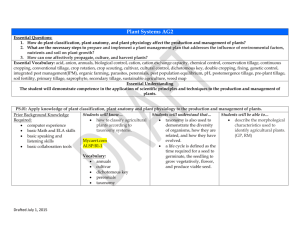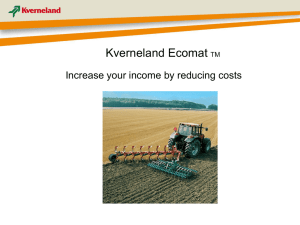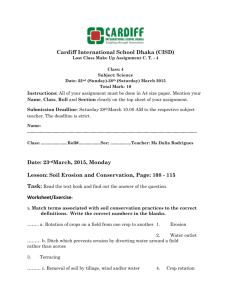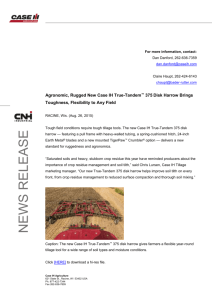Chapter 9 Tillage practices for conservation
advertisement
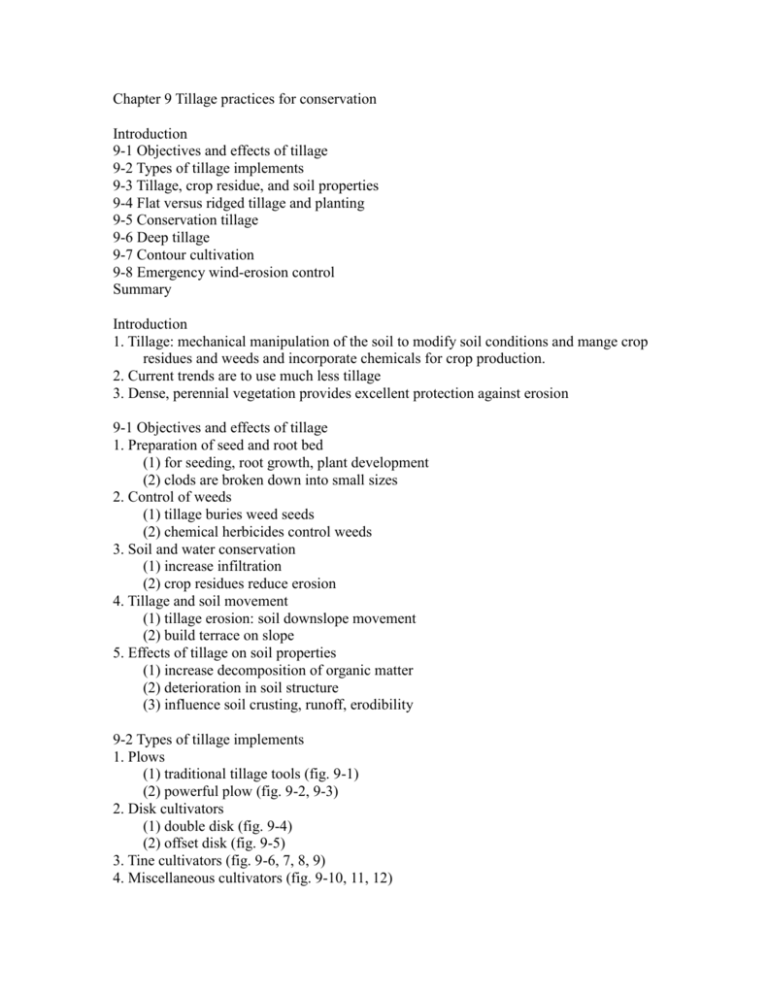
Chapter 9 Tillage practices for conservation Introduction 9-1 Objectives and effects of tillage 9-2 Types of tillage implements 9-3 Tillage, crop residue, and soil properties 9-4 Flat versus ridged tillage and planting 9-5 Conservation tillage 9-6 Deep tillage 9-7 Contour cultivation 9-8 Emergency wind-erosion control Summary Introduction 1. Tillage: mechanical manipulation of the soil to modify soil conditions and mange crop residues and weeds and incorporate chemicals for crop production. 2. Current trends are to use much less tillage 3. Dense, perennial vegetation provides excellent protection against erosion 9-1 Objectives and effects of tillage 1. Preparation of seed and root bed (1) for seeding, root growth, plant development (2) clods are broken down into small sizes 2. Control of weeds (1) tillage buries weed seeds (2) chemical herbicides control weeds 3. Soil and water conservation (1) increase infiltration (2) crop residues reduce erosion 4. Tillage and soil movement (1) tillage erosion: soil downslope movement (2) build terrace on slope 5. Effects of tillage on soil properties (1) increase decomposition of organic matter (2) deterioration in soil structure (3) influence soil crusting, runoff, erodibility 9-2 Types of tillage implements 1. Plows (1) traditional tillage tools (fig. 9-1) (2) powerful plow (fig. 9-2, 9-3) 2. Disk cultivators (1) double disk (fig. 9-4) (2) offset disk (fig. 9-5) 3. Tine cultivators (fig. 9-6, 7, 8, 9) 4. Miscellaneous cultivators (fig. 9-10, 11, 12) 9-3 Tillage, crop residue, and soil properties 1. Nature and distribution of surface crop residues (Table 9-1) 2. Surface soil roughness 3. Clod and ridging 4. Soil infiltration rate 5. Permeability 9-4 Flat versus ridged tillage and planting 1. Seeding on flat between two ridges: in dry soil 2. Seeding on the top of ridge: waterlogged 9-5 Conservation tillage 1. Definition: any tillage or planting system in which at least 30% of the soil surface is covered by plant residue after planting to reduce erosion by water, or where soil erosion by wind is the primary concern, at least 1120 kg/ha of flat small-grain-residue equivalent is on the surface during the critical erosion period. (Schertz, 1988) 2. Stubble mulch tillage: keep crop residue on the surface to protect both crops and soils from erosion (fig. 9-13) (1) field experience with stubble mulch tillage: best adapted to semiarid regions (2) causes of lowered crop yields: less weed control, poor seedbed quality, lower spring soil temperature, reduce nitrogen supply (3) implements for stubble mulch tillage: undercutting tools are recommended (fig. 9-13) 3. Reduced tillage (1) reduced preplant tillage: plow-plant, wheel-track-plant, till-plant, strip tillage (2) reduced pre- and postplanting tillage: (fig. 9-14, 15) (3) choosing the appropriate implement: (Table 9-1, fig. 9-16) (4) adjusting the individual machine: (5) cost and energy requirements of reduced tillage (6) reduced tillage and soil compaction (7) reduced tillage and runoff (85%) and erosion (42%) losses (8) adapting reduced tillage systems to soils 4. No-till (fig. 9-17, 18) (1) drill or planter, sprayer to apply pesticides, harvester to bring in the crop (2) benefits: lower fuel and machinery cost, less soil compaction, better runoff and erosion control (Table 9-2) (3) chemical vs. mechanical weed control (Table 9-3) 5. Current use and future of conservation tillage (1) minimum tillage in 1963 (2) 63-82% of cropland will be conservation tilled by 2010 (3) conservation tilled increased from 25.6-35.8% in US (Table 9-4) (4) extension and conservation personnel 9-6 Deep tillage 1. Deep chiseling and subsoiling (1) deep chiseling: 30-40 cm depth (fig. 9-19) (2) subsoiling: >50 cm depth (3) vertical mulching: filled with crop residues 2. Deep plowing: 90 cm or 1.8 m depth (1) productive soil is buried by unproductive soil (2) precautions for sandy soil 9-7 Contour cultivation 1. Contour cultivation, erosion, and crop yields (1) reduce soil erosion 40-80% (fig. 9-20) (2) increase crop yields, corn 10%, wheat 29%, soybeans 11% 2. Drawbacks of contour cultivation (1) inconvenient, short rows, extra turning (2) increase labor and machinery time and cost 3. When and where to use contour cultivation (1) gentle and short slope (2) terracing for steep and long slope 4. Farming a contoured field (1) no uniform-width contour strips (fig. 9-21) (2) carry water safely 5. Contour furrows for rangeland and pastureland (1) design and construction of range furrow (2) range pitting: 9-8 Emergency wind-erosion control 1. Emergency tillage for wind-erosion control (1) roughen soil surface (fig. 9-22) (2) across the direction of wind 2. Emergency tillage and crop damage (1) destroys some plants (2) reduce crop yields (Table 9-5) 3. Implement operation Summary 1. Three objectives of tillage (1) prepare a seed and root bed (2) control weeds (3) prepare the soil to absorb water 2. Conservation tillage (1) stubble mulch tillage (2) reduced tillage (3) no-till 3. Deep chiseling or subsoiling 4. Contour cultivation 5. Emergency tillage
